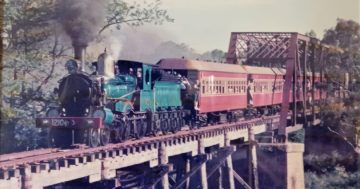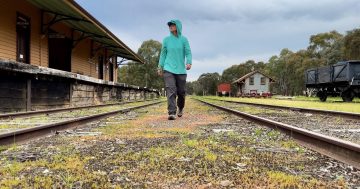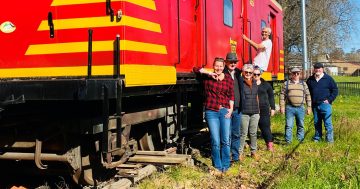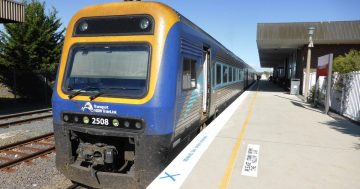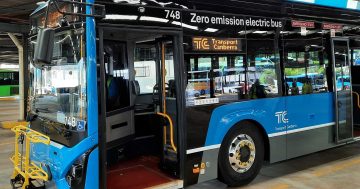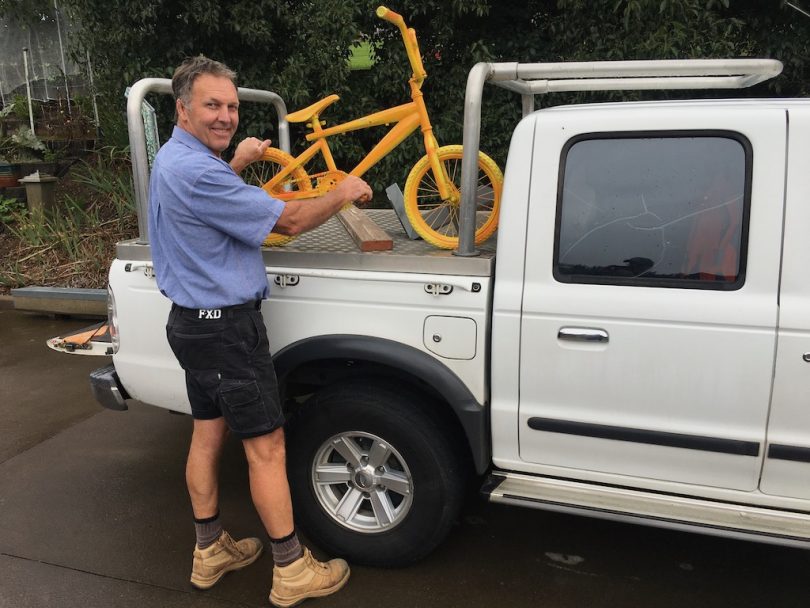
Neil Penning prepares another yellow bike to keep the conversation going about a 57-kilometre rail trail between Goulburn and Crookwell. Photo: John Thistleton.
Bolted on the back of a ute, resting against letterboxes, standing in office windows or strapped to trees, yellow bikes are spreading across Goulburn and Crookwell.
Neil Penning’s first yellow bike – a trick bike his mate John Guthrie made 30 years ago from bits and pieces – went on display at the front of his home in November. The aim is to stir up curiosity about the proposed 57-kilometre rail trail for cycling and walking between Goulburn to Crookwell.
“This is a ground-up approach as opposed to a top-down approach,” Neil said.
An electrician with a record for hands-on volunteering, he and the ‘Friends of Goulburn Crookwell Rail Trail’ continue to build community support incrementally.
After more than a decade of speaking to landholders along the proposed route, learning about successful rail trails and their challenges, Neil said deep-rooted community support was the best foundation for the $15 million project.
He became even more convinced of this strategy after seeing a ‘top-down’ approach incite hostility towards the project at a public meeting in November 2018. He said consultants running the public meeting couldn’t answer basic questions about the proposal.
He first saw a yellow bike campaign for a separate rail trail project on a poster at a roadhouse near Gundagai. It was in stark contrast to the strident opposition evident in ‘No Rail Trail” signs painted on sheets of corrugated iron placed prominently around Wagga Wagga.
A similar grassroots approach is now drawing committed followers along the Goulburn to Crookwell route.
“There’s a really keen little group in Crookwell,” Neil said. “There is more in this rail trail for Crookwell relatively speaking than Goulburn. The trail can attract 20,000 people in a year, which is ho-hum for Goulburn but pretty significant for Crookwell.”
He said the first rail trail in NSW from Tumbarumba to Rosewood opened midway through the pandemic and attracted more than 20,000 visitors a year. “They just can’t believe it,” he said.
When finally approved, proponents of the Tumbarumba project reduced their costs by selling sections of the old steel railway line to India.
Neil said revenue from visitors’ overnight accommodation would justify the investment between Goulburn and Crookwell.
“That’s why ground-level activity has to happen first,” he said. “People on the street, running coffee shops and motels have to get involved at a ground level because this will all fall over if visitors cannot get overnight accommodation.
“So the plan is community engagement, getting the yellow bikes out, getting people talking. Painted bikes are distributed at annual shows and market days to followers getting on board. The original Goulburn-Crookwell Rail Trail Inc. is still working on the proposal as well.
“The worst thing is we are running out of bikes. We have 10 (in hand) to paint and 20 promised. That was always going to happen.”
Supporters must also answer and document key questions, such as the trail’s economic viability, security and biosecurity through food-producing land adjoining either side of Crown Land on which the sealed surface would run.
When the original branch line opened in 1902 farmers didn’t want fences dividing their paddocks. Ultimately, the track was deemed ‘low volume’ and went unfenced.
Unlike early days, livestock poses a risk to cyclists and walkers. Consequently, much of the trail must be fenced and underpasses and four-way gates erected. The gates need the capacity to close in two directions to provide access to landholders on either side.
Once necessary documentation is gathered, supporters will again head to the NSW Government. They believe this can be achieved within 12 months.
Ian Anderson’s property ‘Graywood Siding’ – 25 kilometres north of Goulburn in the Woodhouselee area – sits on the edge of the Upper Lachlan Shire boundary with Goulburn Mulwaree.
A strong rail trail supporter, Ian remained confident a biosecurity strategy could address the concerns of seed potato producers.
Some potato seed farmer growers along the proposed trail are worried that their crops could be infected by pests and disease and there have been calls for a buffer zone.
Ian said cyclists would have more respect for the wildlife than others who had entered his property, including illegal wood carters and quad and trail bike riders.
During Woodhouselee’s early European history, the Gray brothers earned praise after building a rail siding for their farm produce.
Ian said this enterprise could be reawakened by tourists using the rail trail and stopping at the siding. Visitors would also change Goulburn from a stop-over to a destination.












